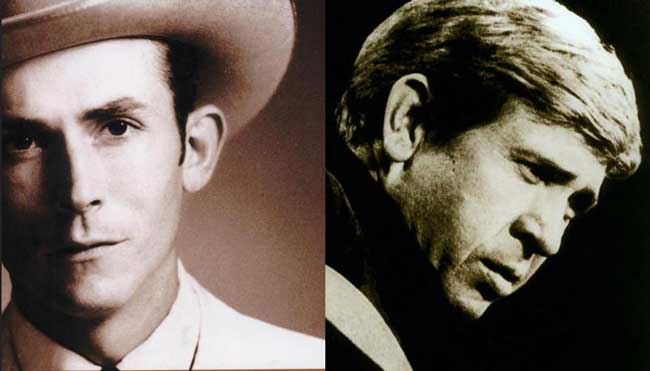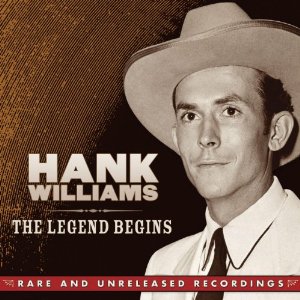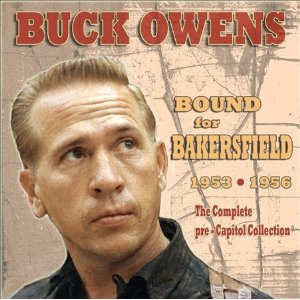Before They Were Legends
A foreshadowing of greatness in Hank Williams’s first recordings and Buck Owens’s pre-Capitol recordings
By David McGee
THE LEGEND BEGINS: RARE
AND UNRELEASED RECORDINGS
Hank Williams
Time Life
BOUND FOR BAKERSFIELD,
1953-1956: THE COMPLETE
PRE-CAPITOL COLLECTION
Buck Owens
RockBeat RecordsHearing the first recordings of country giants on the order of Hank Williams and Buck Owens is a thrilling experience in and of itself, and two new releases offer exactly that--first recordings and the thrill of hearing these influential artists in their seminal stages. This enthusiasm, though, is tempered by the fact of most of this material--two of the three discs in the Hank set, the entire Buck disc--having been previously released, in the case of the Buck disc as recently as 2008. None of which makes the performances any less fascinating, even if the packages containing them are a bit less than essential.
Hank’s The Legend Begins has the most to recommend it as a new release. Its big news is the third disc, which lives up to its title “Rare and Unreleased” by including the earliest known recording young Hank ever made, in 1938 or ’39, as a 15-year-old and four 1940 home recordings from the archives of Hank’s sister Irene. The disc is rounded out by a short radio show Hank and Audrey performed in 1951 for the March of Dimes at a moment in American history when polio was ravaging the populace. In his mid-teens Hank, accompanied by his accordionist friend Pee Wee Moultrie, cut a swinging version of Frankie “Half Pint” Jaxon’s 1928 double-entendre blues, “Fan It” (subsequently recorded by Isham Jones, Milton Brown and Bob Wills, among others), and backed it with a sprightly workout on “Alexander’s Ragtime Band.” Though Moultrie is indicated as being Hank’s only accompanist, an announcer (possibly Moultrie) introduces each song, and other voices can be heard shouting encouragement on “Fan It” and other instruments are present on “Alexander’s Ragtime Band,” including what sounds like a calliope, lending an amusement park ambianc to the performance. The blues focus continues on the four home recordings, with a confident reading of “Freight Train Blues,” from Roy Acuff’s catalogue; a quick sprint through “New San Antonio Rose”; a nondescript harmonica-and-guitar instrumental version of “St. Louis Blues”; and “Greenback Dollar” given a driving, Appalachian folk-flavored treatment, hearkening back to the song’s origin. Though only in his mid-teens when he made these recordings, Hank’s singing, though yet to find its individuality, is strong and confident beyond his years. The 1951 March of Dimes show, recorded for broadcast between January 15-31, features almost as much Hank speaking emotionally about the polio scare--this was, after all, a fund raiser--as it does him singing songs. He does manage a terrific version of his latest hit, “Moanin’ the Blues,” with some rich support from Helms’s steel and Rivers’s fiddle. Audrey offers an amateurish “There’s a Bluebird On Your Windowsill” ahead of Hank speaking passionately for nearly two minutes about the ravages of polio and the need to find a cure, then brings Audrey back to join him on “Help Me Understand,” a tearjerking Luke the Drifter narration about the emotional havoc a divorce wreaks on a couple’s child, who prays to God for help in understanding what’s happening to her family. An uneven affair to this point, Hank made a memorable exit, with a powerful, deeply committed rendition of black gospel songwriter Cleavant Derrick’s plea for salvation, “When God Dips His Love In My Heart.” In the span of time documented on this disc, Hank moves from an imitative teen with an obvious but undeveloped musical gift to the most influential and popular country artist of his time, a honky tonk pioneer now spawning countless imitators of his own and, unbeknownst to him, constructing a fundamental cornerstone of early rock ‘n’ roll's foundation.
Hank Williams, ‘Lovesick Blues’Discs 1 and 2 contain the Health & Happiness radio shows from 1949 (sponsored by the patent medicine Hadacol, which was 12 percent alcohol), performing many of what became his landmark songs, with wife Audrey being given the spotlight on occasion to do her pale imitation of Kitty Wells (there’s a reason she has been referred to as “the Yoko Ono of country music” and not solely for her disruptive presence) and Jerry Rivers signing off the proceedings with fiery fiddle breaks. But when Hank’s on, he’s really on: on Disc 1, he's at his bluesiest best on “Lovesick Blues”; deeply affecting in “Tramp On the Street,” the song about Jesus being mistaken for a tramp and dying forsaken on the street; an aggrieved honky tonker in “I’m a Long Gone Daddy,” acerbic and cocksure; severe and soulful on the hymn, “When God Comes and Gathers His Jewels,” one of the four singles he cut for the Sterling label before being signed to MGM. The shows on Disc 2 follow the same pattern: bluesy tearjerkers (“There’ll Be No Teardrops Tonight”), keening, steel-drenched spiritual messages (“The Prodigal Son”), fiddle-fired gospel raveups (“I Saw the Light”), spirited honky-tonk advisories (“Mind Your Own Business”), lachrymose death ballads (“I’ve Just Told Mama Goodbye”), a preview of the then-unrecorded heartbreaker that became a country music landmark, “I’m So Lonesome I Could Cry,” and, on this disc, one of Hank’s most powerful appeals to brotherhood, Pee Wee King-Red Stewart’s “Thy Burdens Are Greater Than Mine.” At this juncture Hank was a fully mature vocalist capable of credibly adopting whatever persona the song called for--from the preacher to the tush hog--his confidence no doubt buttressed by the empathetic, savvy support of the Drifting Cowboys (with steel guitarist Don Helms beginning to burnish his legend with some breathtaking fills serving as a second emotive voice to Hank’s, and fiddler Rivers adding some wonderful shading, especially on bluesier fare such as “I’m So Lonesome I Could Cry”).
Hank Williams and the Grand Ole Opry cast, ‘I Saw the Light,’ featuring solos by Roy Acuff and HankOriginally released on two CDs by Mercury Nashville in 1993, this new edition of the Health and Happiness Shows improves the original sonics, removing the snaps and crackles from the ’93 set with sparkling, crisp audio restoration by a master of the art, Joe Palmaccio, all the better to illustrate, as critic Alanna Nash wrote in her review of the first collection, “what [Hank] was like in his molassified, hayseed ("if the good Lord's willin' and the creek don't rise") glory.”
As Ms. Nash indicates, in the Health and Happiness Shows we hear a fully formed Hank Williams. In Bound for Bakersfield 1953-1956, we hear a Buck Owens in his pre-Capitol odyssey, moving from label to label, trying out various styles, but, when all is said and done, finding his voice and sound by the time Capitol’s Ken Nelson snatched him up before Columbia’s Don Law could sign him to a recording contract. Buck’s wanderings back in those days, when he was also supporting himself with a day job, included playing in other bands, fronting his own bands, doing session work in L.A. and recording for Pep, New Star, Chesterfield and La Brea, the latter of which released an entire Buck album. His scattered early recording history apparently included a release or releases on the Dixie label, and the owner of the Pep label leased some of Buck’s recordings to other labels, including Starday--in his later years Buck was annoyed to find bootlegs of his early recordings showing up on labels he had never heard of.
Buck Owens, ‘Hot Dog,’ a rockabilly track he wrote and originally recorded in 1956 as Corky Jones, so as not to alienate his country audience. ‘'Hot Dog’ was spun off of Elvis,' he said. 'Had it not been for Elvis, I wouldn’t have been singin’ no rockabilly songs.' ’Hot Dog’ was released by the Pep label in 1956.Shortly after moving from his native Texas to Bakersfield, California, as a young married man in 1951, Buck made his first important professional decision by ditching his Gibson hollow-body guitar for the steelier sounding Fender Telecaster. He wasn’t exactly on his way, but he was getting there in his attempt to assemble his own sound out of all that was in the air at the time. Early on, in his first recording, a 1953 demo of “Blue Love” (heard here in a finished version as well), Buck sings in a plaintive, otherwise unremarkable tenor on a track featuring a honky-tonk piano, steel guitar and Dixieland trumpet, a la Bob Wills. When he re-recorded the track for the La Brea label (which did not issue it until 1960, when Buck was signed to Capitol and in the midst of his first run of Top 5 country singles--a bonafide star), the Dixieland trumpet was gone, the vocal was considerably more anguished and smarter altogether in its emotional shadings, and it was a straight-ahead, no frills honky tonk tearjerker. The songwriting was coming together in a major way by 1955 when he recorded the wonderfully syncopated “Down On the Corner of Love” (a song he and his guitarist Don Rich would have a great time performing in later years with its catchy vocal rises and dips in the chorus bringing out the best in their vocal partnership) and the sad, heartbreaking ballad, “It Don’t Show On Me,” wherein we hear some of the agile wordplay he would come to master when he describes his love life as “abused, unused, refused, misused.” Come 1956 and the rise of Elvis Presley, Buck attempted to appropriate some of the Hillbilly Cat’s energy in two sizzling rockabilly numbers, “Hot Dog” and “Rhythm and Booze,” singing like Eddie Cochran (a hopped up Eddie Cochran on the latter tune, in fact) as Roy Nichols fired off some rousing double-stop solos on the Telecaster over a driving shuffle beat (his solo is even hotter on the overdubbed single version included here). Fearing he might alienate the country music business with these Pep singles, he billed himself as Corky Jones, and later admitted that “‘Hot Dog’ was spun off of Elvis. Had it not been for Elvis, I wouldn’t have been singin’ no rockabilly songs.” What became “the Bakersfield Sound” starts to surface in a series of tracks Buck produced himself, with a band featuring Nichols on guitar, Fuzzy Owen on bass, Lawrence Williams on piano, Ray Heath on drums and an unidentified but inspired steel player. These include two versions of the exquisite breakup ballad “There Goes My Love” (Buck adopting a Webb Pierce crying vocal style here) and two runs at Buck’s catchy midtempo love song, “Sweethearts in Heaven” featuring a gospel-inspired high tenor dueting with Buck on the choruses in what would become a familiar sound signature after Don Rich joined the band.
Later Buck, with Don Rich and the Buckaroos, ‘Foolin’ Around’As Hank did on “Help Me Understand,” so does Buck on the cloying “Why Don’t My Mommy Stay With My Daddy and Me?,” in depicting a child’s devastation over his parents’ divorce, which Buck sells with a poignant but fairly restrained vocal bordering on but never crossing the line into melodrama. This track, along with the new version of “Blue Love,” a tasty guitar instrumental (“Honeysuckle”) and six others were all recorded in Bakersfield in 1956, with Buck backed by a tight trio of Junior Stonebarger on pedal steel, Lewis Talley on bass and Jack Trent on piano. As good as they are on “Blue Love,” they truly get lowdown on the 12-bar blues, “I’m Gonna Blow,” a dark, stomping number keyed by Trent’s pumping piano, about a fellow deep sixing his gal after he spots her with another guy, then second guessing himself and promising to rob a bank in order to buy her a bunch of fancy things if she’ll come back to him. Buck never wrote another song quite like this. It’s a fitting conclusion to Bound for Bakersfield, because by the time of the later sessions documented on this disc, he was dug in deep in Bakersfield, hard at work building his own personal fiefdom, forge his hard-earned legend, changing country music, affecting a new generation of rock ‘n’ rollers and fashioning a sound forever vibrant. It was only a matter of time.
Hank Williams: The Legend Begins--Rare & Unreleased Recordings is available at www.amazon.com
Founder/Publisher/Editor: David McGee
Contributing Editors: Billy Altman, Laura Fissinger, Christopher Hill, Derk Richardson
Logo Design: John Mendelsohn (www.johnmendelsohn.com)
Website Design: Kieran McGee (www.kieranmcgee.com)
Staff Photographers: Audrey Harrod (Louisville, KY; www.flickr.com/audreyharrod), Alicia Zappier (New York)
E-mail: thebluegrassspecial@gmail.com
Mailing Address: David McGee, 201 W. 85 St.—5B, New York, NY 10024





